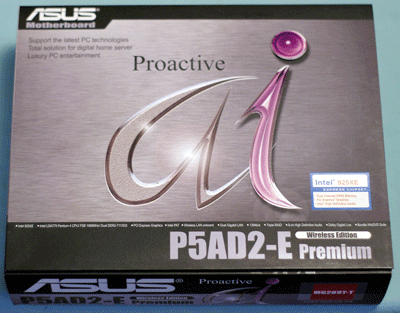FIRST LOOK: Asus P5AD2-E - 1066FSB & DDR2-711
by Wesley Fink on November 29, 2004 12:01 AM EST- Posted in
- Motherboards
When Intel introduced the new Socket 775 architecture in late June, two new chipsets were launched to drive the new 775 Prescotts. The 915 was targeted at mainstream users, and the more expensive 925X was to drive the enthusiast level boards. In our August roundup of all the top 925X motherboards, the Asus P5AD2 Premium received our Gold Editors Choice as top Intel motherboard. It is worth looking back at Intel 925X Roundup: Creative Engineering 101 to see the challenges faced by board makers. Most were trying to find creative ways to circumvent design limitations for the 925x/915, which limited overclocking to about 10%. Asus had the most successful solution, packaged in an incredibly full-featured board whose only drawback was the very high price compared to the competition.
Fast forward 3 months and the Enthusiast seems to be moving in large numbers to the AMD Athlon 64 platform, so Intel has souped-up the 925X/775 to stop the bleeding. We first looked at the new 925XE in Pentium 4 3.46 Extreme Edition and 925XE: 1066MHz FSB Support is Here. We found that the 1066 speed bump was not all we expected, since there was very little improvement in performance compared to the 800FSB 925X. Perhaps even more disappointing was the fact that the only 1066 CPU for some time to come was a 3.46GHz P4EE based on the Gallatin core and the 130nm process. There were no announced Prescott 90nm cores with huge L2 caches running at 1066 in the near future, and there would not be a 4.0GHz Prescott either. For the immediate future, the only official support for 1066FSB would come with the $1050 3.46EE and a to-be-announced 3.73GHz P4EE with the multiplier boosted from 13 to 14.

This is not meant to be a depressing scenario of the current state of Intel, but it would not really be meaningful to look at the new Asus P5AD2-E in isolation. Those looking for the absolute fastest performance should look at Athlon 64 solutions. However, the P5AD2 was and is a brilliant motherboard design, and the -E version should take it even further. It is reasonable to expect the P5AD2-E to take you to the highest levels of Pentium 4 performance.










34 Comments
View All Comments
mkruer - Monday, November 29, 2004 - link
I love Intel’s comment a while back when they stated that their version of dual core would be better because it “shares resource” between the cores.Monkeydonutstick - Monday, November 29, 2004 - link
#22 can you not read?classy - Monday, November 29, 2004 - link
LOL Dothan. Unless you can oc that bad boy extremely it will get crushed by an A64. It does better at gaming than desktop Intel chips, but performs poorly at rendering and the like. Stop with Pentium M Dothan nonsense. And by the way, the motherboards are priced in server board territory. Lets OC an Athlon 64 platform and see the scorching the Dothan will get.Monkeydonutstick - Monday, November 29, 2004 - link
http://translate.google.com/translate?sourceid=nav...ariafrost - Monday, November 29, 2004 - link
But Dothan doesn't scale up to high clock speeds and won't compete directly with Athlon 64 procs...Monkeydonutstick - Monday, November 29, 2004 - link
Try Dothan with a faster bus. preliminary benchmarks show a clock for clock intel advantageWesley Fink - Monday, November 29, 2004 - link
#17 - This is a First Look review and not a full motherboard review. As we explained when we launched First Look, we will use that format to bring more motherboard reviews more quickly to AnandTech readers. PCMark 04 is used to provide a braod General Performance comparison that includes media encoding in the benchmark.We did run a full suite of benchmarks for future comparisons, but nothing really changes.
925XE/3.46EE - 925X/3.6E - nF4/FX55 - Benchmark
34.1 - 34.4 - 39.3 - MM Content Creation 04
26.7 - 26.5 - 31.1 - Business Winstone 04
73.1 - 73.4 - 69.1 - AutoGK DivX 5.1.1
danidentity - Monday, November 29, 2004 - link
#13 - Ugh, Intel's answer is EM64T, which is functionally identical to AMD64 and is fully compatible with it. CPUs supporting it will be on sale before WinXP-64 is released.About the review, WHY do you have a ton of gaming benchmarks and only a single solitary non-gaming benchmark. Do you think the people who read your reviews do nothing but play games? I'd like to see an equal number of non-gaming benchmarks. Content creation, business apps, encoding, etc.
Also, why didn't you test an 800MHz FSB CPU in this board? The overclocking potential is much better because of the 1066MHz FSB support.
smn198 - Monday, November 29, 2004 - link
No. I didn't have a pre-production 50MHz CPU ;)I meant 550MHz
smn198 - Monday, November 29, 2004 - link
Haven't bought an Intel CPU since I had my K7 50Mhz a long time ago but I really did like my PII 233 @ 350. I'd switch back to Intel in an instant if they offered better price:performance.